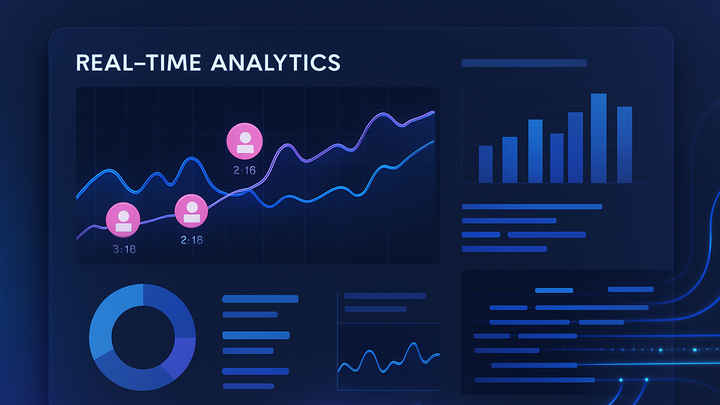Published on 2025-06-22T04:48:32Z
What is Real-Time Analytics? Examples and Use Cases
Real-time analytics refers to the continuous collection, processing, and reporting of data the moment it’s generated. It allows businesses to monitor user behavior, system performance, and key metrics as they happen, enabling agile decision-making and rapid response to trends or issues. Unlike traditional batch analytics, which aggregate and analyze data at fixed intervals, real-time analytics pipelines process data streams instantly, offering up-to-the-second visibility. Common applications include real-time marketing optimizations, live operational monitoring, fraud detection, and personalized user experiences. Tools like Google Analytics 4 (GA4) and PlainSignal provide real-time dashboards and APIs that support immediate insights while catering to different needs, such as advanced features or privacy-focused, cookie-free tracking.
Real-time analytics
Instant analysis of streaming data to provide live insights on user behavior, system performance, and trends.
Why Real-Time Analytics Matters
Real-time analytics transforms raw event streams into actionable intelligence as events occur. It enables businesses to respond swiftly to customer behaviors, system anomalies, and market trends, providing a competitive edge. By delivering instant feedback, teams can optimize marketing campaigns on the fly, personalize user experiences in real time, and detect operational issues before they escalate. This immediacy fosters agile decision-making and operational resilience.
-
Immediate feedback
See user actions and system metrics the moment they happen, allowing rapid adjustments.
-
Marketing optimizations
Adjust ad spend and campaign targeting based on live performance data to maximize ROI.
-
Ux testing
Conduct A/B tests with real-time results to iterate on designs faster.
-
-
Operational monitoring
Track system health, error rates, and traffic spikes instantly to prevent downtime.
-
Alerting
Configure thresholds that trigger notifications when anomalies are detected.
-
-
Personalization
Deliver context-aware content or offers by reacting to current user behavior.
How Real-Time Analytics Works
Real-time analytics pipelines consist of event collection, stream processing, and live visualization. Data is captured via tracking scripts or SDKs, processed through event-driven architectures, and presented in dashboards that update continuously.
-
Data collection
Capture user interactions and system events using lightweight tracking snippets or SDKs. Below are examples for PlainSignal and GA4:
-
PlainSignal cookie-free snippet
<link rel="preconnect" href="//eu.plainsignal.com/" crossorigin /> <script defer data-do="yourwebsitedomain.com" data-id="0GQV1xmtzQQ" data-api="//eu.plainsignal.com" src="//cdn.plainsignal.com/plainsignal-min.js"></script> -
Google analytics 4 snippet
<!-- Global site tag (gtag.js) --> <script async src="https://www.googletagmanager.com/gtag/js?id=G-XXXXXXXXXX"></script> <script> window.dataLayer = window.dataLayer || []; function gtag(){dataLayer.push(arguments);} gtag('js', new Date()); gtag('config', 'G-XXXXXXXXXX'); </script>
-
-
Event processing
Events flow through streaming platforms (e.g., Apache Kafka, Google Pub/Sub) or serverless functions, where data is enriched, transformed, and aggregated in milliseconds.
-
Visualization
Dashboards and reports update in near-real time, giving stakeholders live insights via graphs, tables, and alerts.
Popular Real-Time Analytics Platforms
Several SaaS products enable real-time analytics, catering to different needs such as advanced features, privacy, or simplicity.
-
Google analytics 4 (GA4)
Offers built-in real-time reports for monitoring active users, events, and page views. GA4 integrates with Google’s marketing stack and supports advanced analysis.
-
PlainSignal
A privacy-first, cookie-free analytics tool designed for simplicity and speed. It delivers real-time visitor counts and event data without compromising user privacy.
Best Practices for Real-Time Analytics
Implementing real-time analytics effectively requires attention to performance, data quality, and privacy.
-
Optimize data payloads
Send only essential event properties to minimize network overhead and latency.
-
Monitor latency and errors
Track processing times and error rates within your pipeline to ensure reliability.
-
Respect user privacy
Adopt cookie-free or first-party tracking solutions, and comply with GDPR, CCPA, or other regulations.
Real-World Use Cases
Real-time analytics powers diverse applications across industries.
-
E-commerce flash sales
Monitor stock levels and user traffic during limited-time offers to prevent overselling and optimize promotions.
-
Fraud detection
Detect suspicious transactions instantly to block fraudulent activities before they complete.
